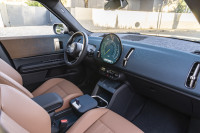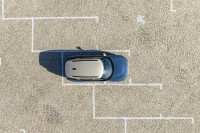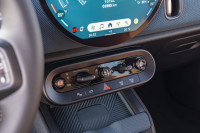The two criticisms that modern Minis are constantly subjected to: they are too heavy and too German. The electric Mini Countryman doesn’t care about that. This compact SUV weighs almost two tons, uses EV technology from BMW and rolls off the production line in Leipzig. We tested the powerful SE version with 313 hp and 494 Nm.
Mini is reinventing itself. All models are being redeveloped from the ground up: from the three-door Cooper and the upcoming Aceman, which will replace the Clubman, to the Countryman – the compact SUV you see here.
While several petrol versions of these models are available alongside electric versions (with the exception of the Aceman), Mini aims to become a fully electric car brand by 2030.


Two electric motors
The electric Countryman is built by BMW and rolls off the same production line in Leipzig as the BMW iX1 (the electric BMW X1) and the iX2. That explains why the drivetrain sounds familiar to us: two electric motors that together distribute 313 hp and 494 Nm of torque to all four wheels.
It doesn’t matter that the car weighs almost 2000 kilos, because a sprint from 0 to 100 is done in 5.6 seconds. To avoid jealous looks on the factory floor, the Countryman SE has not only an identical sprint time but also the same top speed as the BMW iX2, namely 180 km/h.
It is wonderful to notice how elegantly the power of the two electric motors is combined and distributed. Every movement of the accelerator is precisely measured and converted into speed without any delay. Even when you drive sportily, the Countryman reacts neutrally. It uses its good weight distribution, does not understeer annoyingly and offers a lot of feedback from the front axle. You hardly notice its heavy bones when taking bends.


Emptying and charging
As with other electric cars, the range stated in the brochure is difficult to achieve in practice. During our test drive, the on-board computer shows a consumption of 18.9 kWh/100 km, which amounts to a range of 340 kilometers. Mini itself communicates 432 kilometers. We wish the results of the two calculations were closer together.
Charging the 64.6 kWh battery (net) is done at a charging speed of 130 kW. We expect even better from an electric car with the latest BMW technology, but it is fast enough to go from 10 to 80 percent in 30 minutes.
Whether you are waiting at the charging station or driving to your destination, you have plenty of room in the front seats. The legroom in the back is less generous, while the new Countryman offers more freedom of movement than its predecessor. Every occupant experiences the same refined suspension comfort: a good balance between a sporty hard basic tuning with enough spring reserves to still smoothly iron out bumps.

Round as a pancake
You can read how far the charging has progressed on the round touchscreen. You can operate almost all of the car’s functions via this pixel pancake. The menu structure is based on the BMW system, but the round shape and playful design make it less logical.
And Mini no longer places a digital display behind the steering wheel. There is a 3600 euro solution in the form of the S package that includes a head-up display. Incidentally, that package owes its name to the S of Small, the packages M, L and XL are logically even more expensive and more complete.
It was mentioned before: the Mini Countryman will now be built 862 kilometers as the crow flies from London. In Leipzig. And although it cannot match the high level of the BMW iX2 in terms of materials, the quality of finish is just as solid. What’s more, the new Countryman looks like a modern Mini and not a BMW with a stick-on moustache and a bad accent.
The steep front and robust appearance do not make the SUV look particularly streamlined, but its air resistance is still not bad. Compared to its predecessor, the Cd value has dropped from 0.31 to 0.26. The iX1 cuts through the wind just as smoothly, the hatchback-like iX2 even slightly better (0.25).

Two versions
The Countryman SE with two electric motors starts at 49,490 euros, but there is also a ‘regular’ version with one 204 hp electric motor on the front wheels for 43,490 euros. You get the same 64.6 kWh battery and charging takes just as long. That it is slower goes without saying. But know that the towing weight is also reduced (1200 vs. 750 kg).
And although EV subsidy is in the offing with this base price, you won’t succeed. You have four versions and six packages to choose from and with a brand like Mini you can’t avoid ticking thousands of euros worth of extras. Only then does the salesman unlock the handcuff with which he has chained you to the sales desk. When it comes to expensive options, Mini was already a German car brand through and through.
At the same time, a Countryman Electric is so much cheaper than a BMW iX1 or iX2 that hip car bloggers on YouTube would call it a lifehack. Prices for electric BMWs don’t start at 50, but at 60 grand. Whichever car you choose, the BMW factory always wins.

Conclusion
Mini hits the nail on the head with its new interpretation of the Countryman. And then the electric version also benefits from BMW’s beautiful EV technology. The 313 hp Countryman SE offers the power, the flexibility and the comfort that is needed to get hardened petrol drivers out of their trusted Mini and into a Mini of the future.
Source: www.autoreview.nl


